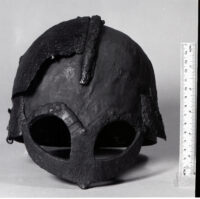 An iron helmet that was discovered in Yarm, North Yorkshire, during sewer work in the 1950s has been confirmed to be an extremely rare Viking-era helmet, only the second nearly complete Viking helmet in the world and the first and only one found in Britain.
An iron helmet that was discovered in Yarm, North Yorkshire, during sewer work in the 1950s has been confirmed to be an extremely rare Viking-era helmet, only the second nearly complete Viking helmet in the world and the first and only one found in Britain.
It was referred to as the Viking helmet from the beginning, but its real age has been an open discussion since its find. It has design elements found in earlier forms from the Anglo-Saxon and Vendel era, and because the only other helmet in the world confirmed to date to the Viking era, the Gjermundbu Helmet found in Haugsbygd, Norway, in 1943, was not a direct comparison, it was difficult to conclusively identify the Yarm Helmet as an Anglo-Scandinavian piece. A new study by Durham University researchers has used recent archaeological finds and analysis of the iron and corrosion products to narrow down its age of manufacture. It is indeed an Anglo-Scandinavian helmet made in northern England in the 10th century.
 With all the traveling and combat during the Viking era from Lindisfarne (793 A.D.) to the last raids by Magnus Barefoot in 1103, you’d think the archaeological record would be replete with Viking helmets, or at least that there would be a few out there. Instead, the early medieval helmets that have been found pre-date the Viking era. They are highly decorative ceremonial pieces discovered in graves. By the 10th century, most Anglo-Saxons and Anglo-Scandinavians were Christian, ergo no more grave goods, ergo extremely rare survivals of helmets. The Gjermundbu Helmet was part of an elaborate funerary furnishing complete with chain mail shirt and weapons, but the Yarm Helmet seems to have been hidden in the watery bank of the River Tees rather than being a burial good.
With all the traveling and combat during the Viking era from Lindisfarne (793 A.D.) to the last raids by Magnus Barefoot in 1103, you’d think the archaeological record would be replete with Viking helmets, or at least that there would be a few out there. Instead, the early medieval helmets that have been found pre-date the Viking era. They are highly decorative ceremonial pieces discovered in graves. By the 10th century, most Anglo-Saxons and Anglo-Scandinavians were Christian, ergo no more grave goods, ergo extremely rare survivals of helmets. The Gjermundbu Helmet was part of an elaborate funerary furnishing complete with chain mail shirt and weapons, but the Yarm Helmet seems to have been hidden in the watery bank of the River Tees rather than being a burial good.
[University of Durham researcher] Dr Caple commented: “We were initially alerted to the object by our colleagues at Preston Park Museum. It was a challenging project, as the thin iron sheet is now very susceptible to corrosion (it has to be kept in very dry conditions), so it was not simply a question of only showing the date at which it was created, but working out how it had survived until it was unearthed in the 1950s. Our analysis showed that it was initially preserved in waterlogged conditions, only later becoming damaged and starting to corrode. Fortunately it was discovered before it corroded away completely
“Although there are half a dozen early medieval helmets from Britain, the Sutton Hoo and Coppergate helmets being the most famous, this is the first Anglo-Scandinavian (Viking) helmet from Britain.
“Whilst the Saxon helmets were often highly decorated and were worn by warrior leaders, as much symbols of authority as helmets, by the 10th century we can now envisage that most professional warriors had helmets like the Yarm Helmet. They were simply manufactured, well designed to protect the wearer (rivets flush with the surface so they did not catch bladed weapons) but no longer decorated. Together with a mail hauberk (shirt of chain mail), a helmet was essential personal protective equipment for a warrior. We see almost all the combatants in the 11th century Bayeux Tapestry wearing helmets and hauberks.”
 The helmet predates the founding of the village of Yarm. It was discovered on the east bank of a loop in the River Tees, which may have been a quayside before the town was established. It is made of simple thin iron plates riveted together with iron bands. At the top of the lateral band is a decorative knop. Attached to the brow band is an iron semicircle divided into two by an iron nose band to form a spectacle mask. A mail curtain was likely attached by holes in the brow band. There are hammer marks visible on the surface and the infill iron plates are ragged at the edges. This was a plain, workmanlike piece intended for hard use, not display or ceremony.
The helmet predates the founding of the village of Yarm. It was discovered on the east bank of a loop in the River Tees, which may have been a quayside before the town was established. It is made of simple thin iron plates riveted together with iron bands. At the top of the lateral band is a decorative knop. Attached to the brow band is an iron semicircle divided into two by an iron nose band to form a spectacle mask. A mail curtain was likely attached by holes in the brow band. There are hammer marks visible on the surface and the infill iron plates are ragged at the edges. This was a plain, workmanlike piece intended for hard use, not display or ceremony.
The Yarm Helmet is on display at the Preston Park Museum in Stockton. The results of the study have been reported in the journal Medieval Archaeology.
I just want to thank you. I look forward to reading your blog every day.
THH Helmets TS-43 GP BLACK ORANGE is a Full-face helmet. It contains 7 air vents- 3 on the jaw 1 on top and 3 on the back for smooth airflow in intake and exhaust.